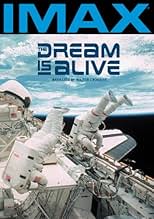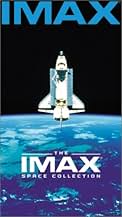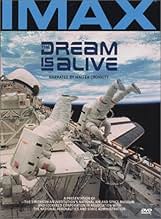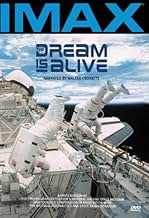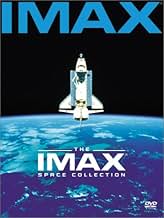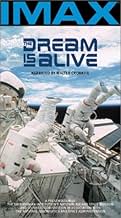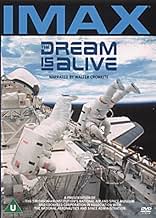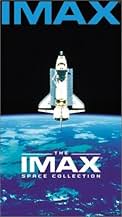अपनी भाषा में प्लॉट जोड़ेंTraveling on the Space Shuttle, covers training, launch, flight, deployment of LDEF from Challenger in April 1984 (STS-41C).Traveling on the Space Shuttle, covers training, launch, flight, deployment of LDEF from Challenger in April 1984 (STS-41C).Traveling on the Space Shuttle, covers training, launch, flight, deployment of LDEF from Challenger in April 1984 (STS-41C).
फ़ीचर्ड समीक्षाएं
I saw this movie at an IMAX film festival a couple of years ago. The shots of the earth from space are amazing, and the best part is, these aren't Hollywood Special Effects. It's all real. Even 15 years after it was made, it's still one of IMAX's best films.
I have had the EXTREME PLEASURE of seeing this SPECTACULAR movie 5 TIMES!!! I would have enjoyed seeing it MANY, MANY MORE TIMES ALSO!!! This is a movie, where after seeing it, you do not come out appreciating what the Astronauts do, I think that you do not appreciate the BEAUTY of SPACE! If I were 5'4", I would have been doing everything that I could so I could get my B. Science degree at a College or University so I could qualify to be on the Waiting List of Potential Astronauts! But, as my luck would have it, I am only 5'1/2", and so, unfortunately, this will have to be in another life... Ah, but the opportunity to see a Sunrise EVERY 90 MINUTES!!!! THAT WOULD BE THE ABSOLUTE BEST THING!!!!!!!!!!!!!!!!!!! IT WOULD BE SIMPLY GORGEOUS!!!
To date, NASA has made five IMAX films that have been shot from the Space Shuttle or the Space Station. "The Dream is Alive" was the first, and is probably still the best. It must be seen on the IMAX screen to fully appreciate it, but still looks and sounds good on DVD if seen on a big television with a good sound system. The launch sequences would be excellent opportunities for audiophiles to display their subwoofers to admiring guests.
Considering that all of the film shot in space was shot by the shuttle crews rather than by professional cameramen, the results are outstanding. This is probably the closest you can get to the sensation of being in space, short of actually going there yourself. There are also excellent ground sequences of the shuttles being assembled, launched, and recovered, along with the training required for astronaut candidates all well chosen to look dramatic in the IMAX format.
The three shuttle missions featured in this film all took place during 1984, and the film was released in the summer of 1985. At the time it was released, NASA was launching shuttle missions at a rate never seen before or since. The film displayed the optimism of the time, where the safety of the flights was not in question, and the goal of everyone flying in space someday seemed to be within reach. NASA had a teacher-in-space program and a journalist-in-space program (as well as an unofficial politician-in-space program, where a congressman and a senator conned their way into space flights), and an ambitious program of fifteen launches was scheduled for 1986. Everything looked rosy, and the film reflects this.
Then, on the first (and only) shuttle launch of 1986, Challenger exploded, killing the crew of seven (including two of this film's cast). The previous optimism vanished, never to fully return, in the light of revelations about unresolved safety issues, unrealistic expectations, etc. The film is thus an artifact of this vanished era, and it's rather sad to see this atmosphere of optimism in the light of what was to follow. Nonetheless, the sequences in the movie are still very effective, and the subsequent IMAX space films have only managed to equal (but not exceed) what is seen here. If you're a space enthusiast, you owe it to yourself to see this at least once in an IMAX theater.
Considering that all of the film shot in space was shot by the shuttle crews rather than by professional cameramen, the results are outstanding. This is probably the closest you can get to the sensation of being in space, short of actually going there yourself. There are also excellent ground sequences of the shuttles being assembled, launched, and recovered, along with the training required for astronaut candidates all well chosen to look dramatic in the IMAX format.
The three shuttle missions featured in this film all took place during 1984, and the film was released in the summer of 1985. At the time it was released, NASA was launching shuttle missions at a rate never seen before or since. The film displayed the optimism of the time, where the safety of the flights was not in question, and the goal of everyone flying in space someday seemed to be within reach. NASA had a teacher-in-space program and a journalist-in-space program (as well as an unofficial politician-in-space program, where a congressman and a senator conned their way into space flights), and an ambitious program of fifteen launches was scheduled for 1986. Everything looked rosy, and the film reflects this.
Then, on the first (and only) shuttle launch of 1986, Challenger exploded, killing the crew of seven (including two of this film's cast). The previous optimism vanished, never to fully return, in the light of revelations about unresolved safety issues, unrealistic expectations, etc. The film is thus an artifact of this vanished era, and it's rather sad to see this atmosphere of optimism in the light of what was to follow. Nonetheless, the sequences in the movie are still very effective, and the subsequent IMAX space films have only managed to equal (but not exceed) what is seen here. If you're a space enthusiast, you owe it to yourself to see this at least once in an IMAX theater.
I just watched this short documentary and was really amazed by the quality of the images since this documentary was made in 1985. But now I see it was an IMAX movie so it does make more sense now. I saw it on my big screen television but I can imagine that in an IMAX theater it must be awesome because the footage and the images are just stunning at times. It's all well done and very interesting to watch and to learn. The narrating voice of Walter Cronkite wasn't annoying at all, it was simple but effective. For the impressive images alone the documentary is already worth the detour. Add on top of that that it's all very interesting especially if you're interested in space and technology. The only minus point was that it was too short. It could have gone on for a couple more hours if it was up to me.
Released a year before the Challenger disaster changed NASA forever, The Dream is Alive tells the story about the space shuttle program, which started in 1981 with the launch of Columbia, and ends with the launch of Challenger. The cinematography and audio were ahead of its time.
क्या आपको पता है
- कनेक्शनReferenced in Premiere Video Perseveres (2011)
टॉप पसंद
रेटिंग देने के लिए साइन-इन करें और वैयक्तिकृत सुझावों के लिए वॉचलिस्ट करें
विवरण
बॉक्स ऑफ़िस
- दुनिया भर में सकल
- $10,44,068
इस पेज में योगदान दें
किसी बदलाव का सुझाव दें या अनुपलब्ध कॉन्टेंट जोड़ें

